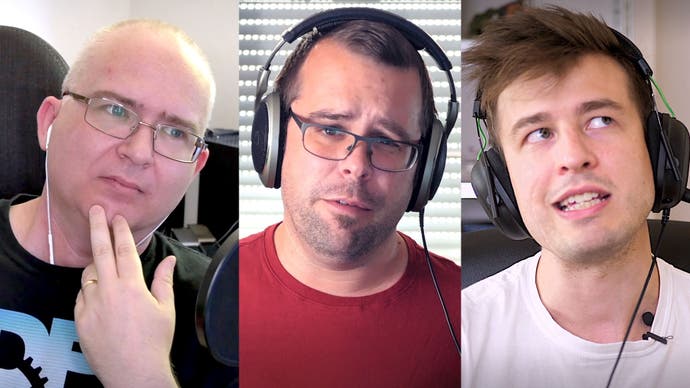DF Direct Weekly on PS5 1440p support and The Last Of Us Part 1's gameplay reveal
Plus: a crucial turning point in the fortunes of VR?
Welcome to the latest edition of DF Direct Weekly - the 72nd, in fact. This is Digital Foundry's weekly show, where the team down tools for an hour or so to discuss the latest gaming and technology news. After a couple of weeks away, myself and John Linneman have returned to the mics, discussing the latest PlayStation 4 firmware beta offering 1440p display support, along with sharing some thoughts on the latest The Last of Us Part 1 footage. VR is also a hot topic too, with Sony revealing new headset features in the same week that Meta ups prices on the Oculus Meta Quest 2 and the massive multi-billion burn-rate on its metaverse gamble comes into focus.
Kicking off with PlayStation 5's 1440p update, we'll be covering this more extensively, but the headline points are fairly straightforward - the beta firmware works fine with 1440p displays, with a new test option that puts any connected display through its paces at 1440p resolution in both 60Hz and 120Hz, and in both HDR and SDR modes. From there, everything works exactly as it should - typically, games are downscaled from their 4K outputs to 1440p, providing a form of super-sampling anti-aliasing. In the Direct, we talk about why this is a good thing and how responsive Sony has been to feedback in recent times - something we've not necessarily experienced so readily in the past. Quite how native 1440p game content runs with the 1440p display output is something we're testing right now, so look out for a piece on this soon.
Beyond that, our focus turns to the new The Last of Us Part 1 developer diary, where Naughty Dog go into more depth on how the game has been enhanced over the original in the wake of 'hurtful' leaks. What's good about this video is how Naughty Dog firmly sets expectations - there's clearly a lot of technology from TLOU2 used here, but at the same time, certain gameplay mechanics won't be used, simply because the levels were not designed for them. The explanation of 'not different but better' sums it up quite nicely, and we look forward to going hands on with the game.
- 00:00:00 Introduction: Rich, John and Alex return!
- 00:00:43 News 1: 1440p output support in new PS5 beta firmware
- 00:13:49 News 2: TLOU Part 1 gameplay showcase video released
- 00:20:31 News 3: PSVR 2 features detailed, Quest 2 price increased
- 00:34:10 News 4: Xbox boot times shortened with faster boot video
- 00:39:07 News 5: Returnal port updated with Steam Deck support
- 00:43:38 DF Content Discussion: Alex’s i9-12900K upgrade
- 00:59:28 DF Supporter Q1: Given the stutter issues on Unreal Engine, is it better to just play UE games on consoles?
- 01:07:45 DF Supporter Q2: Is there a way to get pre-cached shaders for EGS games on Steam Deck?
- 01:09:39 DF Supporter Q3: Why do so many Switch games lack anti-aliasing?
- 01:13:55 DF Supporter Q4: DLSS has a fixed cost, so have you ever seen a scenario where DLSS was slower than regular rendering?
- 01:15:43 DF Supporter Q5: If the next Switch can achieve performance similar to Series S, will major third party games come back to Nintendo?
- 01:19:46 DF Supporter Q6: When playing on PC, what is your personal target frame-rate?
Sony also revealed a touch more on its PSVR2 headset last week, at the same time as Facebook/Meta increased prices on the Quest 2 MHD by $100 in the wake of some bruising financials. The Quest and Quest 2 are simply terrific devices - brilliant, accessible technology. However, VR is still not a mainstream proposition, and the proliferation of the Quest in its niche has, arguably, stunted VR development for PC and consoles where we've yet to see any kind of answer to the incredible Half-Life Al. PSVR2 could make the difference here, for sure, and last week's feature reveal highlights once again that Sony has got the specs and capabilities of its hardware just right. It's also an out-and-out games device, whereas the Oculus hardware has been co-opted into Facebook/Meta's dream of the Metaverse.
I can't help but feel like a technological luddite bearing in mind some of the discourse - not to mention the mind-boggling investments being made - but I've yet to see any kind of compelling use-case for the Metaverse, while the demos put out by the company have been massive underwhelming. Regardless, my primary interest is in gaming and I hope to see PSVR2 make an impact - though as discussed in the Direct, PC support may be a pipedream.
The implications of supposed Steam Deck support for Returnal are covered this week, plus Alex spends some time discussing his satisfaction with his Core i9-12900K CPU upgrade. This platform represents our 'top tier' gaming platform for his PC tech reviews, while Will Judd and myself are also updating to 12900K for our next wave of GPU tests, starting with an Intel Arc A380 review coming soon.
As always, we end with Digital Foundry supporter Q+A, where the ongoing #StutterStruggle continues to dominate discussion and Switch's anti-aliasing challenges are exaplained. Is DLSS ever slower than native resolution rendering, and could a next-gen Switch approach the performance level of Xbox Series S? It's an interesting topic, but I do fear we're falling into the trap of expecting too much performance from a Nintendo system - something that happens without fail every time a new Nintendo system is mooted. And finally - what's our preferred frame-rate target? Q+A is one of our favourite parts of the show and just one element of our brilliant community over on the supporter program. So please, do consider joining us!


